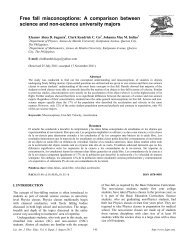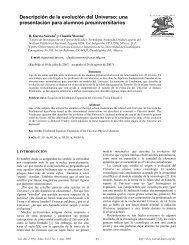Traveling along a zipline
Traveling along a zipline
Traveling along a zipline
Create successful ePaper yourself
Turn your PDF publications into a flip-book with our unique Google optimized e-Paper software.
Carl E. Mungan and Trevor C. Lipscombe<br />
f 10 , and L 1 so that X 0.898389 and Y 0.339010 .<br />
The limiting cases are 0 for which the trajectory is a catenary,<br />
and for which the trajectory is an ellipse, as explained in<br />
Sec. III. (For the case of , there are short vertical segments at<br />
the two ends of the trajectory, whose lengths are determined by<br />
requiring the <strong>zipline</strong> to tauten when the rider clips on.) Do not<br />
confuse these trajectories of the rider with the shapes of the <strong>zipline</strong><br />
for a fixed position of the rider (as shown in Fig. 1 for example).<br />
III. SHAPE OF ANY PIECE OF THE CABLE<br />
THAT DOES NOT INCLUDE THE RIDER<br />
Equation (8) can be inverted to obtain f in terms of x . That<br />
expression can then be substituted into Eq. (10) to obtain<br />
y<br />
1<br />
2<br />
a cosh ln a 1<br />
2<br />
a bx<br />
b<br />
.<br />
(18)<br />
Therefore, any piece of the cable that does not include the<br />
rider’s point of attachment is a catenary [8]. An alternative<br />
way to derive this result is to rewrite Eq. (5) as<br />
dy / dx a b / L , differentiate both sides of it with respect<br />
2 1/2<br />
to x, substitute d / dx (1 [ dy / dx ] ) , and finally switch<br />
to normalized coordinates to obtain<br />
2<br />
d y dy<br />
b 1 .<br />
2<br />
dx<br />
dx<br />
2<br />
(19)<br />
By defining z dy / dx with z0a, Eq. (19) can be<br />
integrated twice to get Eq. (18).<br />
For example, suppose a a 0 and b b 0 as given by Eq.<br />
(12). Then Fig. 3 is a plot of Eq. (18) for a unit length of the<br />
cable making angles i 30 and f 0 at its two ends.<br />
The initial end is at the origin and the final end is at position<br />
( XY , ) given by Eqs. (9) and (11).<br />
FIGURE 3. Shape of a rider-free <strong>zipline</strong> (of unit length L 1)<br />
when the angles the line makes (relative to the horizontal) at its two<br />
ends (indicated by the black dots) are i 30 and f 0 . The<br />
curve is a portion of a hyperbolic cosine whose minimum is at the<br />
right-hand endpoint, where X 0.951427 and Y 0.267949 .<br />
If the rider is much heavier than the cable, then the<br />
tension in the <strong>zipline</strong> gets very large and hence b 0 . In<br />
that limit, Eq. (18) reduces to simply y ax . In other words,<br />
the cable consists of one straight segment from the origin to<br />
the rider and a second straight segment from the rider to the<br />
right-hand end. For any given value of f, the rider’s<br />
coordinates can then be determined from the constraint that<br />
the total length of the cable is L. Since the rider moves such<br />
that the sum of his distances to the two endpoints is fixed, he<br />
travels <strong>along</strong> an elliptical trajectory through space. In<br />
contrast, if the rider is much lighter than the cable, then he<br />
hardly distorts its shape and his trajectory is consequently the<br />
catenary described by Eq. (18).<br />
IV. CONCLUSIONS<br />
Traditionally, the problem in a mechanics course of a<br />
hanging cable consists in finding its shape, both theoretically<br />
and experimentally, under a variety of different conditions<br />
including some novel ones [9–11]. The present paper instead<br />
computes the distortion in a <strong>zipline</strong> as a weight slowly<br />
moves <strong>along</strong> its length. As that traveling mass increases from<br />
zero to infinity, the trajectory is found to interpolate between<br />
a hyperbolic cosine and an ellipse, as plotted in Fig. 2.<br />
Instructors or students eager to quickly reproduce that figure<br />
merely have to set the sum of Eqs. (8) and (16) to Eq. (9),<br />
and the sum of Eqs. (10) and (17) to Eq. (11), then use a<br />
numerical solver to find the values of a and b (for any given f<br />
and ). Armed with these values, one can immediately plot<br />
( xy , ) as f is varied from 0 to 1 for fixed .<br />
Remarkably, no numerical technique other than finding<br />
the simultaneous roots of a pair of algebraic equations is<br />
needed to compute these trajectories. Thus this problem is<br />
appropriate for the intermediate classical mechanics course<br />
(traditionally taken in the sophomore or junior undergraduate<br />
years of the physics major). It would make an interesting<br />
student project to actually measure the coordinates of a<br />
hanging weight placed at various positions <strong>along</strong> a<br />
suspended cable and compare it to the present theoretical<br />
results. In addition to extending familiar variational ideas,<br />
the loaded <strong>zipline</strong> has importance as a physical model of<br />
curved space. Further, the results here could be of interest to<br />
actual users of <strong>zipline</strong>s who wish to safely clear obstacles.<br />
REFERENCES<br />
[1] O’Keefe, R., A circular catenary, Am. J. Phys. 64, 660–<br />
661 (1996).<br />
[2] Fallis, M.C., Hanging shapes of nonuniform cables, Am.<br />
J. Phys. 65, 117–122 (1997).<br />
[3] Gruber, R. P., Gruber, A. D., Hamilton, R. and Matthews,<br />
S. M., Space curvature and the “heavy banana paradox”,<br />
Phys. Teach. 29, 147–149 (1991).<br />
[4] Ellingson, J. G., The deflection of light by the Sun due to<br />
three-space curvature, Am. J. Phys. 55, 759–760 (1987).<br />
Lat. Am. J. Phys. Educ. Vol. 5, No. 1, March 2011 8 http://www.lajpe.org



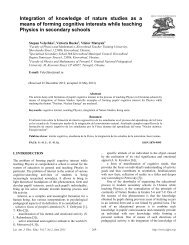
![Diversas formas de visualizar estados en un sistema cuántico [PDF]](https://img.yumpu.com/51151303/1/190x245/diversas-formas-de-visualizar-estados-en-un-sistema-cuantico-pdf.jpg?quality=85)

![Precession and nutation visualized [PDF]](https://img.yumpu.com/50786044/1/190x245/precession-and-nutation-visualized-pdf.jpg?quality=85)
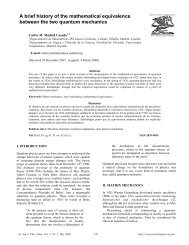
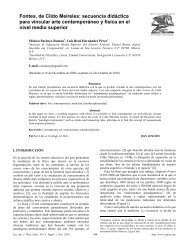
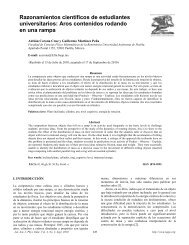

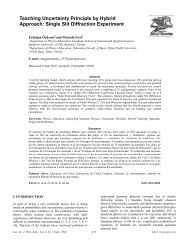
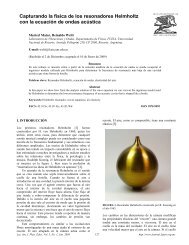
![Index [PDF] - Latin-American Journal of Physics Education](https://img.yumpu.com/47984121/1/190x245/index-pdf-latin-american-journal-of-physics-education.jpg?quality=85)
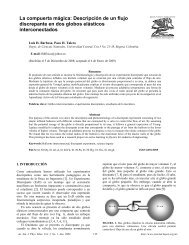
![Flujo de agua en botellas como experimento didáctico [PDF]](https://img.yumpu.com/43536300/1/190x245/flujo-de-agua-en-botellas-como-experimento-didactico-pdf.jpg?quality=85)
